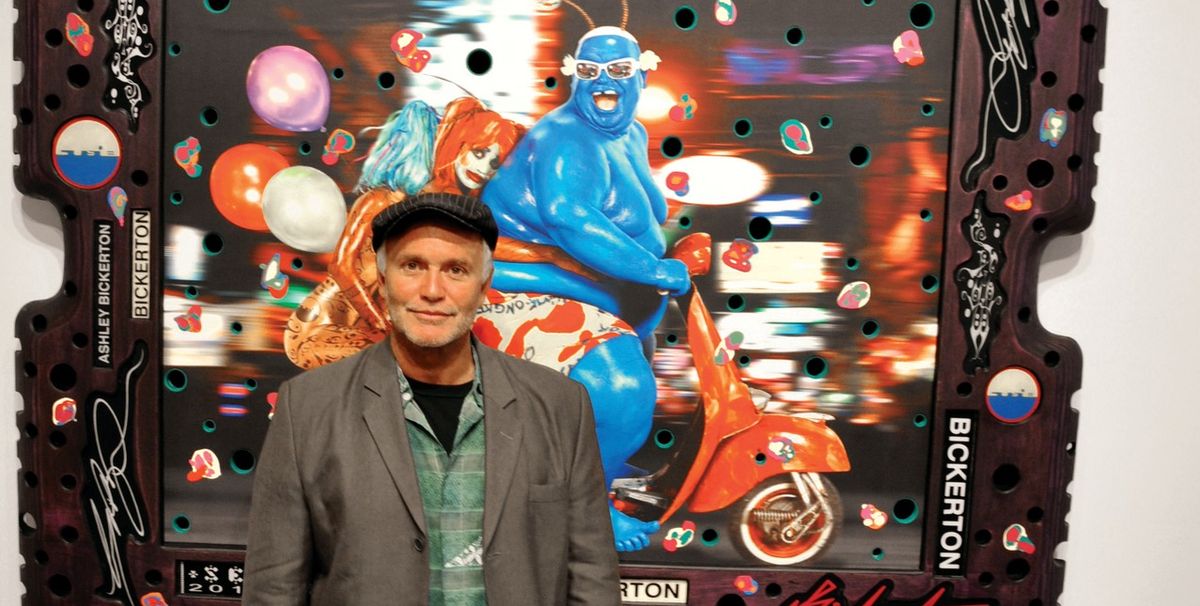When Ashley Bickerton first met Damien Hirst in New York in the late 1980s, his initial reaction was “Who the hell is this obnoxious little monster?” But “horror quickly gave way to pleasure”, Bickerton says, and the pair soon became close friends.
Around 30 years later, Bickerton is opening his first major retrospective in the UK thanks to Hirst, who has been collecting the artist’s work since the early 2000s. Ornamental Hysteria (21 April-20 August) features 50 works spanning more than three decades, most which are drawn from Hirst’s collection.
The exhibition includes examples of Bickerton’s consumerist assemblages from the 1980s and pieces from his early and garishly coloured Travelogues series. It also includes works featuring the blue man, a character that began to appear in Bickerton’s paintings after he moved from New York to Bali in 1993. Bickerton describes the character, who is loosely based on Gauguin, as a “parody of the archetypal 19th-century anti-hero”.
He has also created new pieces for the show that will “unite the disparate directions” his work has taken. They include Double Manta II (White) (2017), a nod to Bickerton’s earlier resin sculptures of sharks, and an updated version of his Wall-Wall series, first conceived in 1986.
When Hirst met Bickerton in New York, the latter had recently shot to fame as a celebrated member of the Neo-Geo movement, alongside Jeff Koons and Peter Halley. “At that time the art world in New York was stultifying, airless and claustrophobic in its uptightness and ambition. The YBAs were a big breath of fresh–or skanky–air. They didn’t mind being publicly ridiculous,” Bickerton says.
Bickerton, who was born in Barbados, decided to escape New York after his market crashed. “We got blown to the top very, very quickly, and then suddenly unceremoniously tossed out. We all spent some time in the wilderness, I know Koons did,” he says. “Instead of experiencing a kind of wilderness in New York, I chose to go to the real wilderness.”
The artist says he had also grown tired of spending his time driving around Brooklyn, meeting with fabricators. “I just felt that wasn’t the life of an artist. I wanted to live a life of poetry and feeling, not stuck in traffic on the Williamsburg Bridge,” Bickerton says. “I had become alienated from the process. That’s why Damien reverted to painting too. You want to control it from beginning to end. We are both artists who need to go both ways.”
Once in Bali, Bickerton struggled with the “deeply cloying” cliché trotted out by Gauguin in Tahiti 100 years earlier. “I was desperate to avoid becoming one of those wispy characters you would see painting folkloric scenes in dollops of pastel colours. But even though I hermetically sealed myself in my studio in Bali it seeped through the cracks and air ducts,” he says.
Bickerton had his first comeback in 1996 with a show at Sonnabend gallery in New York. “It was the same day or the day before Damien’s first big show at Gagosian,” he recollects. “It was my angriest show ever, by a shot, and it was created on a tropical island. It was full of grotesque characters and anthropological outrage, although I actually planned the entire body of work in New York, but I had to leave to make it.”
For Bickerton, the Newport Street Gallery exhibition is less of a homecoming, more a coming full circle. “I’ve had such a tortuous, bifurcated career trajectory I really don’t know who I am as an artist,” he says. “I believe I’m going to see the overarching structure with the Newport Street Gallery show: my life as a surfer and my life as a New York artist.”


